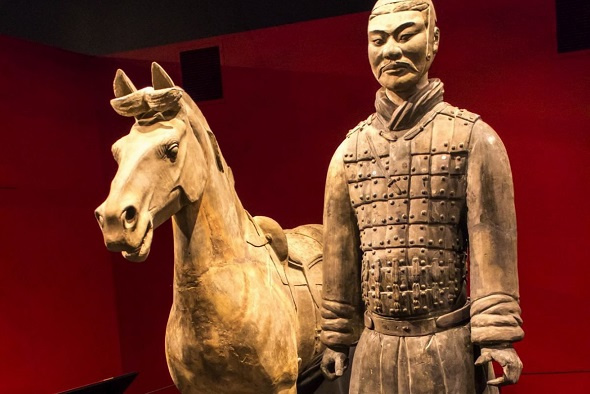
The thumb of a 2,000-year-old terracotta warrior was stolen while on display at the Franklin Institute. (Photo provided to China Daily)
Despite the theft of a thumb of a national treasure statue during display at a U.S. museum, an expert said it will not deter China's efforts to promote cultural exchange through artwork exhibition overseas.
"The exhibition of cultural relics overseas can not only promote a nation's culture, but also promote communication between different countries," Wu Haiyun, from Shaanxi Cultural Heritage Promotion Center, told China Central Television on Feb 19, after the thumb of a 2,000-year-old Terracotta Warrior statue from the tomb of China's first emperor was stolen while on display at the Franklin Institute in Philadelphia.
Answering questions about the risk involved in overseas exhibition of cultural relics, Wu said it is similar to risks involved in driving – one should not give up driving out of fear for a road accident, what we should do is to step up protection measures.
"With a heightened awareness of (protection of cultural relics), we should display cultural relics as much as possible, and put on exhibition outside showcase if possible," said Wu.
The stolen thumb comes from a life-size clay soldier which is part of an exhibit in the Franklin Institute composed of more than 100 cultural relics from Northwest China's Shaanxi province. The solider is part of a "Terracotta Army" that provided after-life security at the burial complex of China's first emperor, Qin Shihuang (259-210 BC).
Wu said displaying cultural relics overseas follows a set of strict regulations.
He said there are more than 8,000 pieces of terracotta warriors, horses and chariots found in the Mausoleum of Emperor Qin Shihuang, and no more than 10 pieces of them are allowed to be put on exhibition overseas at a single time, according to the regulations of the State Administration of Cultural Relics.
Wu said as an international common practice, some of the country's most treasured cultural relics, such as the Bronze Chariot and Horse from the Mausoleum of Emperor Qin Shihuang - which is considered one of the best bronze artworks in China - are not allowed to be put on display overseas.
According to law enforcement authorities of the U.S., the stolen thumb was recovered five days after it was being snapped off from the clay solider.
The Shaanxi Cultural Heritage Exchange Center has sent a letter of protest to the Philadelphia museum and was seeking initiation of a compensation procedure. It will also sent repair experts to repair the broken statue before taking it home.
The exhibit in the Franklin Institute will run through March 4.


















































